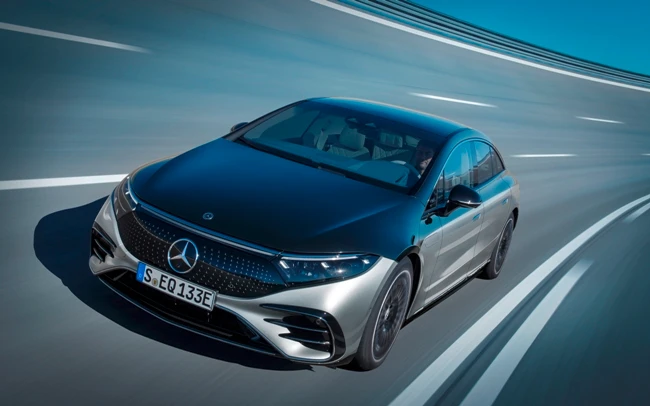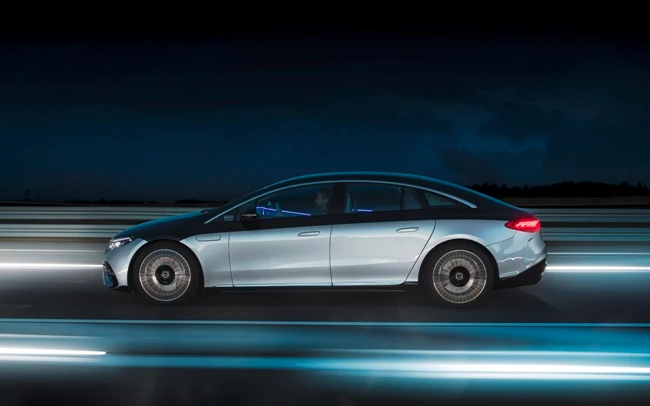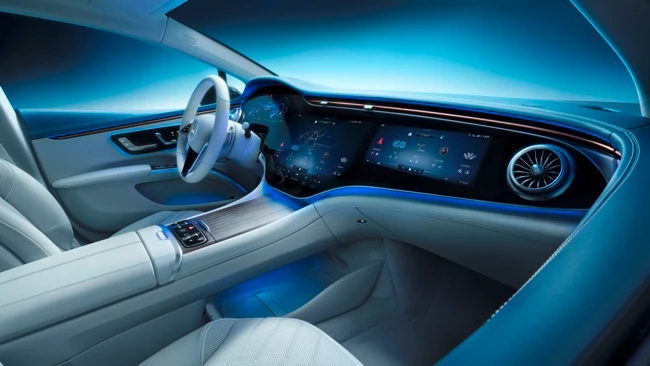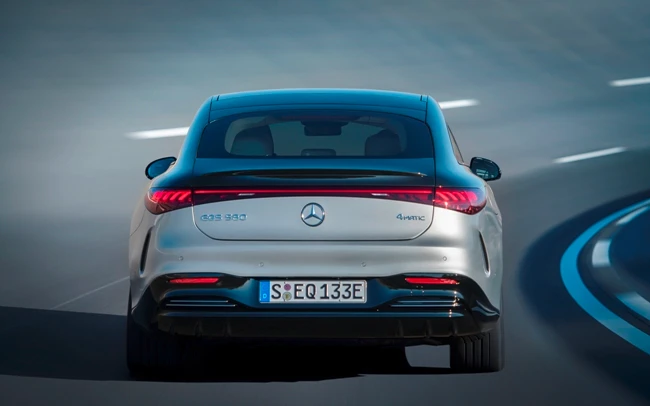European cars
History Made: Mercedes-Benz EQS
Mercedes-Benz has long been seen as the leader in trickle-down technology being seen in cars some years after featuring in the brand’s higher end saloons such as the S-Class. And with the release of their first all electric luxury vehicle, the EQS, this tradition is set to continue.
The EQS will offer ranges of up to 770 kilometres and will pack a powertrain of up to 385kW. A performance version is said to be in development and with up to 560kW. It will sit within the expectations of the S-Class saloon segment. The vehicles will be rear axle driven however the models fitted with the 4MATIC will have a front axle engine also.

Mercedes-EQ, EQS, V 297, 2021
Mercedes says the initial models will be the EQS 450+ with 245 kW and the EQS 580 4MATIC with 385 kW. The rated power consumption rates are quoted as 20.4-15.7 kWh/100 km, and 21.8-17.4 kWh/100 km. New technology for the batteries has them enabled with a higher energy density. Of the two batteries to be available, the larger will have a usable energy content of 107.8 kWh. Mercedes says this is around 26 percent more than the EQC, their EV SUV.
It’s tech that is bespoke for M-B, with the software having been fully developed by the company and allowing over the air updates. This keeps the management system up to date, and for the life cycle of the battery. In respect to the charging rates, the DC fast charge stations pump in 200kW( and 300km in around 15 minutes. On a home charger system the EQS charges up to 22kW with AC power. The software will also allow intelligent charging programs and battery-saving charging.
A key component of EV technology is is energy recuperation. The EQS uses a program called DAuto, which can recuperate energy from deceleration to zero without the need for the brake pedal to be utilised. Smart cruise tech employs the same mechanisms with vehicle traffic ahead of the EQS. Intelligent energy recovery is situation-optimised with the aid of ECO Assist and acts with foresight, taking into account traffic conditions or topography, among other things, and up to 290kW can be generated. The driver also can set three energy recovery levels and the coast function via paddle shifters on the steering wheel.

Mercedes-EQ, EQS, V 297, 2021
Also available as OTA or over the air will be the activation of vehicle functionalities. This includes two driving programs for younger aged drivers and for service staff. Light entertainment in the installation of games will also be available. Plus the updates will allow personal preference settings such as changing the steering angles for the rear wheel steering from the standard 4.5 degrees to the maximum 10 degrees. Planned is the activation of subscription services and testing on future programs.
Aerodynamics plays a big part in vehicle fuel efficiency and the new EQS has plenty of aero in the design. in fact, it’s currently rated as the most aerodynamic car available with a drag coefficient of 0.20cD. In conjunction with that slippery body is the reduction of wind noise at speed, improving comfort levels.
The need for aero is due to the EQS being on a new chassis architecture to provide a home for the powertrain. Mercedes-Benz calls the design language Sensual Purity, with smooth, organic, lines, a reduction in the join lines in panels, the fastback styling. The front end is a “Black Panel” look with the headlights running seamlessly into the grille panel which can be optioned with a 3D star pattern to complement the three-pointed Mercedes star.
Embedded throughout the EQS is a network of sensors, up to 350 of them, depending on specification. Amongst the types of information recorded are distance travelled, ambient lighting conditions, acceleration rates and speeds achieved. AI then utilises these datasets to adjust the car on the fly. This includes monitoring the battery charge levels in respect to the distance required to see the next charging point thanks to the onboard Navigation with Electric Intelligence.

Mercedes-EQ, EQS 580 4MATIC, Interieur, Nevagrau/ Iridescentblau, AMG-Line, Edition 1; MBUX Hyperscreen; ( Stromverbrauch kombiniert: 20,0-16,9 kWh/100 km; CO2-Emissionen kombiniert: 0 g/km) // Mercedes-EQ, EQS 580 4MATIC, Interior, neva gray/ iridescent blue, AMG-Line, Edition 1; MBUX Hyperscreen ; (combined electrical consumption: 20.0-16.9 kWh/100 km; combined CO2 emissions: 0 g/km)
Being a class-setting EV, the EQS packs in some high-end green technology for the passengers. An example is the HEPA filter than can be set to fully clean the air inside the cabin before passengers enter with the onboard data system, MBUX, able to display particulate levels inside and out. Recycled materials are used in areas such as the carpets. The manufacturing process is fully carbon-offset as well.
The MBUX Hyperscreen is the absolute highlight in the interior. This large, curved screen unit sweeps almost from A-pillar to A-pillar. Three screens sit under a cover glass and appear to merge into one. The 12.3-inch OLED display for the front passenger gives him or her their own display and control area. The entertainment functions are only available there while the car is being driven in accordance with the country-specific legal regulations. Mercedes-EQ relies on an intelligent, camera-based locking logic: if the camera detects that the driver is looking at the front passenger display, it is automatically dimmed.
As part of its Ambition 2039 initiative, Mercedes-Benz is working on offering a carbon-neutral new car fleet within 20 years from now. By as early as 2030, the company wants more than half the cars it sells to feature electric drive systems – this includes fully electric vehicles and plug-in hybrids. In many areas, Mercedes is already thinking about tomorrow today: the new EQS is designed to be correspondingly sustainable. The vehicles are produced in a carbon-neutral manner, and resource-saving materials such as carpets made from recycled yarn are used. This is because Mercedes-Benz considers the entire value chain, from development and the supplier network to its own production. Mercedes-Benz AG has had its climate protection targets confirmed by the Science Based Targets Initiative (SBTI).

Mercedes-EQ, EQS, V 297, 2021
Mercedes Commits to a Broad Line-up, Despite Fixed-Price Strategy
Hot on the heels of Japanese rival Honda, Mercedes-Benz is set to restructure its business as it moves towards an agency-style structure in the new car market down under. The move is pencilled in for January 1, 2022, although the luxury auto-maker is still working to put the finishing touches on all the details before then.
Explaining the changes
Like Honda, it is expected that Mercedes-Benz dealers will take on a role whereby they act as an agent for the parent company. With this, prices will also be fixed, the parent company will dictate terms of business, and headquarters will also hold all vehicle stock, thereby limiting the potential for customers to negotiate directly with the dealer.
Unlike its rival, however, Mercedes-Benz has suggested that it will look to differentiate itself in one key area from what Honda is currently doing – that is, by committing to retain the breadth of its model line-up and not cut any entry-level variants.
In supporting this plan, the company points to the fact that it is seeing success in the luxury component of every segment, where it is “winning” in most of these areas. So while Honda might have plans to deliberately streamline its line-up and cut total sales volumes in order to generate higher margins, Mercedes-Benz is going about things differently.

Why there still might be less ‘choice’
Mercedes-Benz will also focus on customer service and satisfaction by addressing core areas that it has identified as important. This includes improving the accessibility to purchase any vehicle from its range online, and also embracing transparent pricing.
Although Mercedes-Benz has committed to its broad line-up, there is still an expectation that each model range will be simplified so as to improve the buying experience for customers by minimising confusion. After all, sometimes too many choices for something largely similar can be problematic for customers who are not yet ‘over the line’.
There is one potential drawback with this. If Mercedes-Benz does opt to simplify each of its model ranges, there is a possibility that optional extras may be ‘built’ into the existing models that are currently more affordable in each range. The risk here is that prices could very well increase, although at this stage details remain to be seen, even if the company has just increased prices across the board for the third time in just over a year.
The good news sees the breadth of Mercedes-Benz’s line-up set to remain, unaffected by the move towards an agency model. What is found in each range, however, will make for interesting consideration.
The 308 To Peugeot: Update Time For 2022.
Peugeot continues its rollout of updates to their range. With the facelifted 2008 available, and 5008 not far away, it’s time for their mainstay hatchback, the 308, to get the magic wand. There’s one key feature to the change, says Peugeot, and that’s to the body styling.
The wheelbase has been in creased by 55mm, overall length up by 110mm, and height dropped by 20mm, making for a sportier profile. The A-pillar has moved rearwards and is raked more in comparison compared to the previous model. The nose is the new corporate look, complete with the mildly refreshed lion badge. Peugeot will offer seven colours: Olivine Green, Vertigo Blue, Elixir Red, Pearl White, Ice White, Artense Grey, and Perla Nera Black.
The wheelarches sit inside fenders with defined squarish lines, and the rear window line flows stylishly down from the roof into the triple-claw LED powered rear lights. Up front are the vertically themed LED driving lights paired to new LED main lights and strakes on the outer edges of the bumper. Exterior changes have the aero drag down to 0.28cD.
Changes too for the interior, with a futuristic and hard edged style change, along with a more tactile-inclined steering wheel. Changes to the safety package see sensors in the wheel measure hand and finger pressure. This works with the step-up in the semi-autonomous driving level, with Peugeot’s Drive Assist 2.0 (where fitted) which has three new features for the Lane Keep Assist. There are: Semi-automatic lane change, suggests that the driver overtake the vehicle in front and then suggests moving back, from 70 km/h to 180 km/h; Anticipated speed recommendation, the system suggests to the driver that he adapt his speed (acceleration or deceleration) according to the speed limit signs; and Curve speed adaptation, optimises speed according to the curve of the bend, up to 180 km/h.
Blind spot monitoring reaches up to 75 metres behind the 2021 308, with a higher definition rear camera providing up to 180 degrees of rear vision. This integrates into the four camera, 360 degree camera parking assist system. For colder climes there are a heated steering wheel and defrostable windshield. Peugeot include their E-call+” emergency call with passenger number information and location including the direction of the vehicle in the lane.
The boot has up to 28L of underfloor space complementing the standard 412 litres. Fold the rears eats and that increases to 1323 litres. Convenience goes up with teh addition of (model dependent) two USB-C data transfer and charge ports. Phone mirroring is wireless and the new 10.25 inch touchscreen, sitting above a silver coloured and angular centre console, part of the driver oriented cockpit, is more tablet oriented in look and usage. It’s a multi-window capable device, and has features such as a home screen tab and widget functionality.
Sounds come from France’s famed Focal audio group and in selected models listeners will have the Premium Hi-Fi system. There are 10 speakers with 4 aluminium inverted dome TNF tweeters, 4 woofers/mediums with Polyglass membrane and 165mm TMD (Tuned Mass Damper) suspension, plus a central Polyglass unit along with a triple coil subwoofer. Power is rated at 590W from a Class-D 12 channel amplifier, with ARKAMYS sound processing.
To be confirmed for Australia will be a choice of petrol, diesel, and hybrid powered drivetrains. Three petrol engines with differing outputs matched to manual and autos, a pair of diesels with a manual or auto, and two hybrids.
Peugeot lists these as: HYBRID 225 e-EAT8, with 2-wheel drive, with a 132kW PureTech petrol engine and an 81kW electric engine attached to the e-EAT8 gearbox. Emissions are rated as 26 g of C02 per km and up to 59 km of 100% electric range (according to the WLTP protocol, in the process of being approved). The other is HYBRID 180 e-EAT8, 2-wheel drive, combination of a 110kW PureTech engine and an 81kW electric engine attached to the e-EAT8 gearbox. Emissions and range are virtually identical at 25g/100km and up to 60 km of 100% electric range (according to WLTP protocol, in the process of being approved).
Capacity for the lithium ion battery is 12.4kWh, with up to 102kW of power. Charging is said to be either a standard 3.7kW single phase charger or an optional 7.4kW single phase charger.
Final model specifications for the Australian market are yet to be confirmed, as is the release date. However, it’s currently expected to be in early 2022.
Ford Transit 12 Seater Bus: An Icon Returns.
Ford Australia has added the 12-seater Ford Transit Bus to the popular Transit line-up. The 410L RWD 12 Seat Bus comes with a 2.0.L EcoBlue diesel with 125kW of power and 390Nm of torque from 1,600-2,300 rpm, driving a ten speed auto and starts from $63,690 (Manufacturer’s Recommended List Price). Options include High Roof with Overhead Stowage Shelves is $2,500, Prestige Paint is $650 and Satellite Navigation with TMC & Enhanced Voice Control is $600. The engine is EURO 6.2 compliant and standard across the range. It features high-pressure direct fuel injection, an advanced aluminium cylinder head, a high-performance variable geometry turbo plus auto stop-start for maximum fuel efficiency and lower running costs. Service intervals are 30,000km or 12 months.
The engine is EURO 6.2 compliant and standard across the range. It features high-pressure direct fuel injection, an advanced aluminium cylinder head, a high-performance variable geometry turbo plus auto stop-start for maximum fuel efficiency and lower running costs. Service intervals are 30,000km or 12 months.
The Ford Transit Bus along with all Transit vehicles, comes with AEB with Pedestrian Detection as standard. There is also Adaptive Cruise Control, Blind Spot Information System (BLIS) with Rear-Cross Traffic Alert, Lane Keeping Aid and Lane Departure Warning with Driver Alert, plus Traffic Sign Recognition. There is also Automatic High-beam, Automatic headlamps, Automatic front windscreen wipers and a heated windscreen. Front and rear park sensors and a rear camera round out the safety package.
A programmable MyKey and FordPass Connect provide a range of services, along with smartphone access, including remote start and stop, allowing drivers to start their vehicle’s engine with a tap of their smartphone in order to heat or cool the cabin before driving.  Info and technology are accessed via the 8.0 inch touchscreen which operates Ford’s latest SYNC 3 infotainment system with Apple and Android apps as standard and optional voice activated satnav. It also gives access to FordPass Connect, which offers convenient ‘connected car’ technology, pairing with the available FordPass App to simplify customers’ ownership experience and unlock a range of new services including Remote Start and Stop, Remote Lock and Unlock, Live Traffic Updates, Location Services, Vehicle Status and Health Alerts.
Info and technology are accessed via the 8.0 inch touchscreen which operates Ford’s latest SYNC 3 infotainment system with Apple and Android apps as standard and optional voice activated satnav. It also gives access to FordPass Connect, which offers convenient ‘connected car’ technology, pairing with the available FordPass App to simplify customers’ ownership experience and unlock a range of new services including Remote Start and Stop, Remote Lock and Unlock, Live Traffic Updates, Location Services, Vehicle Status and Health Alerts.
Access to the interior for the nine passenger capacity Transit Bus is via a powered left side door. It’s key fob operated or via a dashboard switch. Opt for the high roof version and there is extra storage and LED lighting.

Andrew Birkic, President and CEO, Ford Australia and New Zealand, says: “We know our customers have always loved the Transit Bus, but there’s been a strong demand for it to come with an automatic transmission. We can now deliver on that wish and help groups of Aussies travel in comfort and style, whether that be sports teams off to their big game, a shuttle to the airport, or colleagues heading to a conference.”
Along with the five-year, unlimited kilometre full factory warranty, the Transit Bus is eligible for the Ford Service Benefits program at participating Ford dealerships, which means for items listed in an A or B standard logbook service for the first 4 years or up to 120,000km, whichever comes first, the most you will pay is $399 (incl GST).
Further adding to the ownership experience, Ford Service Benefits also bring Transit Bus owners Auto Club Membership including Roadside Assistance as well as a Service Loan Car and sat-nav mapping updates where available.




